Doc 8168 - Section 4: Arrival and Approach Procedures
1/63
Earn XP
Description and Tags
Extensive coverage of DOC 8168 Section 4 content, as preparation to Airlines Selections or Oral Theoretical Examinations. I tried to create as many quiz as possible, giving priority to content impacting directly Pilot's everyday operations and decisions. I added some "nice-to-know" quizzes to make the student aware of additional content (as long and complicated tables) but without requiring to list all the values. I did not include Helicopters content. I have not covered paragraphs or parts completely useless to pilots and with an end in itself. The main idea behind these quizzes is to understand the general philosophies and the reasoning behind the content, along with learning actual parameters and useful criteria. I tried not to make it a useless collection of "facts" listed in the doc. Enjoy.
Name | Mastery | Learn | Test | Matching | Spaced |
|---|
No study sessions yet.
64 Terms
Which are the segments of an Instrumental Approach Procedure?
Arrival, Initial, Intermediate, Final, Missed Approach
Define a straight-in approach
An approach in which the Final Approach Segment (FAS) and the RWY C/L lie within 30° each other
How is Vat defined mathematically, in the context of Aircraft Category?
1.23Vs1g or 1.3V0
Which are the “aircraft categories” in the context of Approach Procedures? (List all the categories you can remember and the corresponding Vat intervals in knots)
A: <90
B: 91-120
C: 121-140
D: 141-165
E: 166-210
(H: helicopters)
Define OCA/H for a Precision Approach
Lowest altitude or height above RWY THR elevation at which a missed approach must start to ensure compliance with obstacle clearance criteria
Define OCA/H for a Non-Precision Approach
Lowest altitude or height above AD elev, or RWY THR if >2m lower, below which an aircraft cannot descend without infringing obstacle clearance criteria
Define OCA/H for a Circling Approach
Lowest altitude or height above AD elev, below which an aircraft cannot descend without infringing obstacle clearance criteria
Talk about the minimum, optimal and maximum descent gradients and angles in the Final Approach Segment (FAS), differentiating by aircraft category. What are the min/max ROD allowed by the Doc 8168 for FAS with no FAF (VOR/NDB approaches?)
Minimum/Optimal gradient: 5.2% or 3°
Can be increased to
6.5% or 3.7° for cat A,B
6.1% or 3.5° for cat C, D, E
In case of FAS with no FAF (VOR/NDBs approach)
Cat A,B: min 400 fpm to max 655 fpm
Cat C,D,E: min 600 fpm to max 1000 fpm
What obstacle clearance is guaranteed by the MSA or the TAA?
≥1000’ within 25 NM of NAVAID / IAF / IF or a relevant procedure facility
What is the purpose of the Initial Approach Segment?
Maneuvering for the Intermediate segment after having left the enroute structure (following manoevuers as reversal, base turns)
What is the purpose of the Arrival segment?
Leave the enroute airway structure and descend towards the IAF or the beginning of the procedure
What is the purpose of the Intermediate Approach Segment?
Adjust speed and configuration to prepare for final approach. In fact, it’s the segment with the shallowest descent rate
What is the maximum intercept angle between the arrival segment and the initial approach segment?
90° for a PA
120° for a NPA
If no TRK guidance is provided, it’s a DR segment
What is the MOC in the initial approach segment?
1000’ in the primary area, gradually reducing to zero towards the outer edges of the secondary area
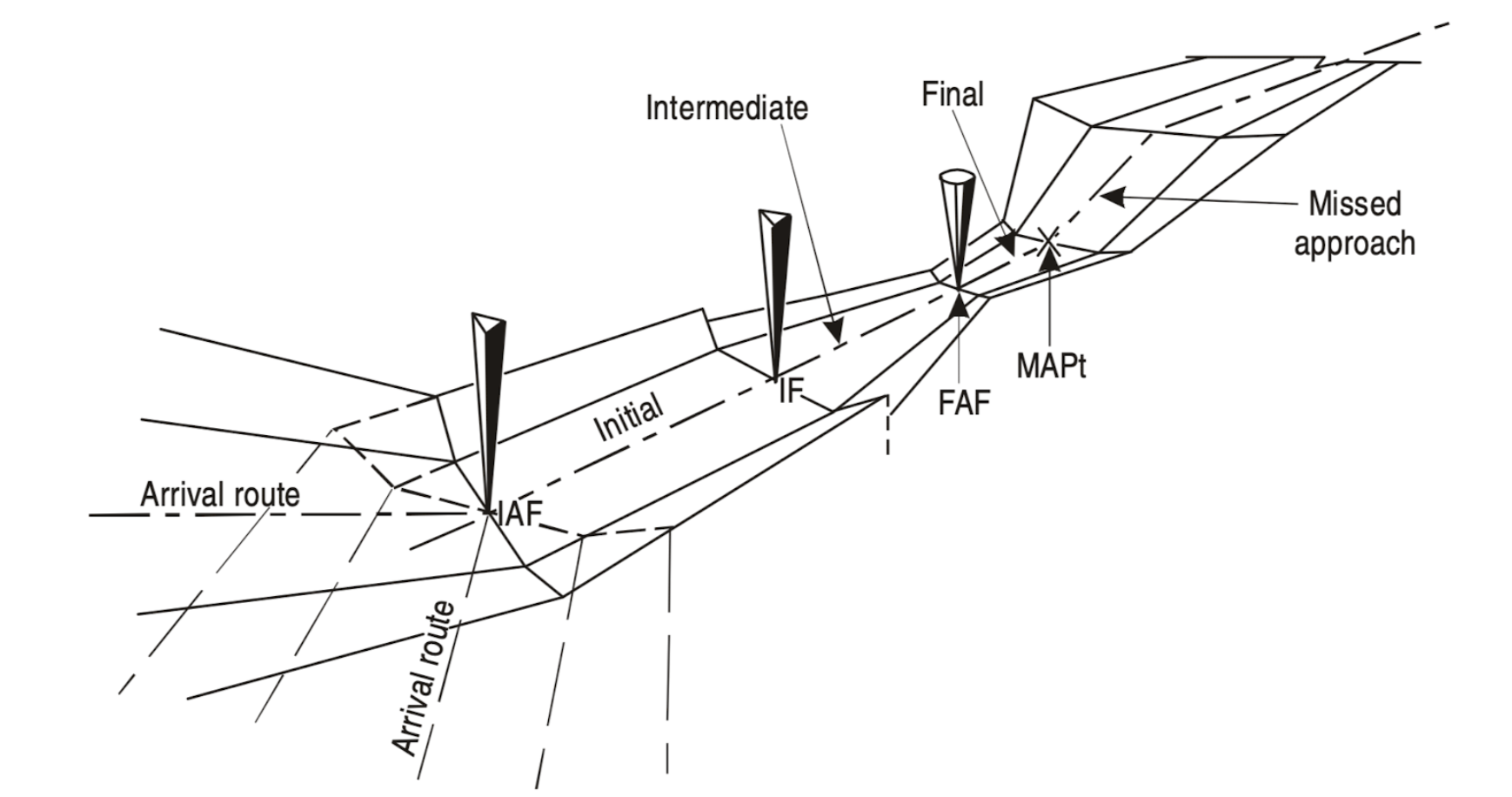
What is the purpose of Procedure turns, Base turns and Racetracks?
To reposition the aircraft in case the IAF/IF do not allow a straight-in approach
Talking about entries, what is the maximum angle allowed to perform a Direct Entry in a Procedure Turn, and respect to what?
30° of the outbound TRK
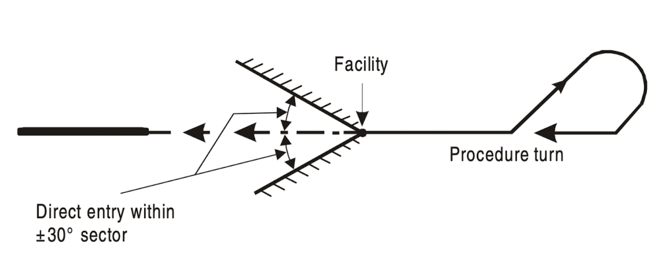
Talking about entries, what is the maximum angle allowed to enter in a Base Turn, and respect to what?
30° of the timed outbound segment + sector required to include the reciprocal of the inbound TRK also
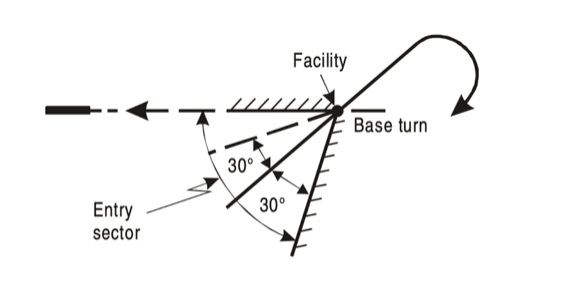
Consider a 45°/180° procedure turn. In which segments is track guidance available, and in which it’s not?
TRK guidance provided for the outbound and the inbound TRK
No TRK guidance in the timed segment, tilted 45° with respect to inbound TRK
Consider a 45°/180° procedure turn. How long can the outbound leg be, and how is it measured?
It’s a timed segment
1’ for cat A, B
1’ 15” for cat. C, D, E
Consider a Base turn. How is defined the end of the outbound leg?
By timing, DME distance or limiting radial
When should timing start in a racetrack?
Abeam the fix or when reaching the outbound heading, whichever comes later
When should you start to turn inbound, in a racetrack?
When reaching the timing / DME distance / limiting radial, whichever comes first
Describe an Offset Entry to a Racetrack
Follow the 30° offset TRK for 1’30”, then fly parallel to outbound TRK for remainder of outbound time.
If outbound time is 1’, fly the offset TRK for 1’ only
What is the crucial difference between a Parallel entry for a Holding and for a Racetrack?
When performing a parallel entry to a racetrack, it’s mandatory to intercept the inbound TRK before reaching the fix. In a holding, it’s allowed to either intercept the inbound try or fly directly to the fix after the inbound turn
When is an aircraft established, speaking about ILS and VOR?
Within half scale deflection
When is an aircraft established, speaking about NDBs?
Within +-5° of required bearing
What are the minimum and maximum descent rates in a reversal or racetrack procedure?
It depends on aircraft category and which TRK is being considered
Cat. A,B
INBOUND TRK max 800, min /
OUTBOUND TRK max 1200, min /
Cat. C,D,E
INBOUND TRK max 655, min 400
OUTBOUND TRK max 1000, min 600
What is the DR segment, in the context of an ILS procedure? Which is its maximum length?
The DR segment intercepts the LOC at 45° at the beginning of the intermediate segment (in the IF). Its max length is 10NM
What is the purpose of the Final Approach Segment?
Alignment and descend for landing
What is the MOC in the intermediate approach segment?
1000’ reducing to 500’ in the primary area, going IF to FAF. Laterally, reducing to zero at the end of the secondary area
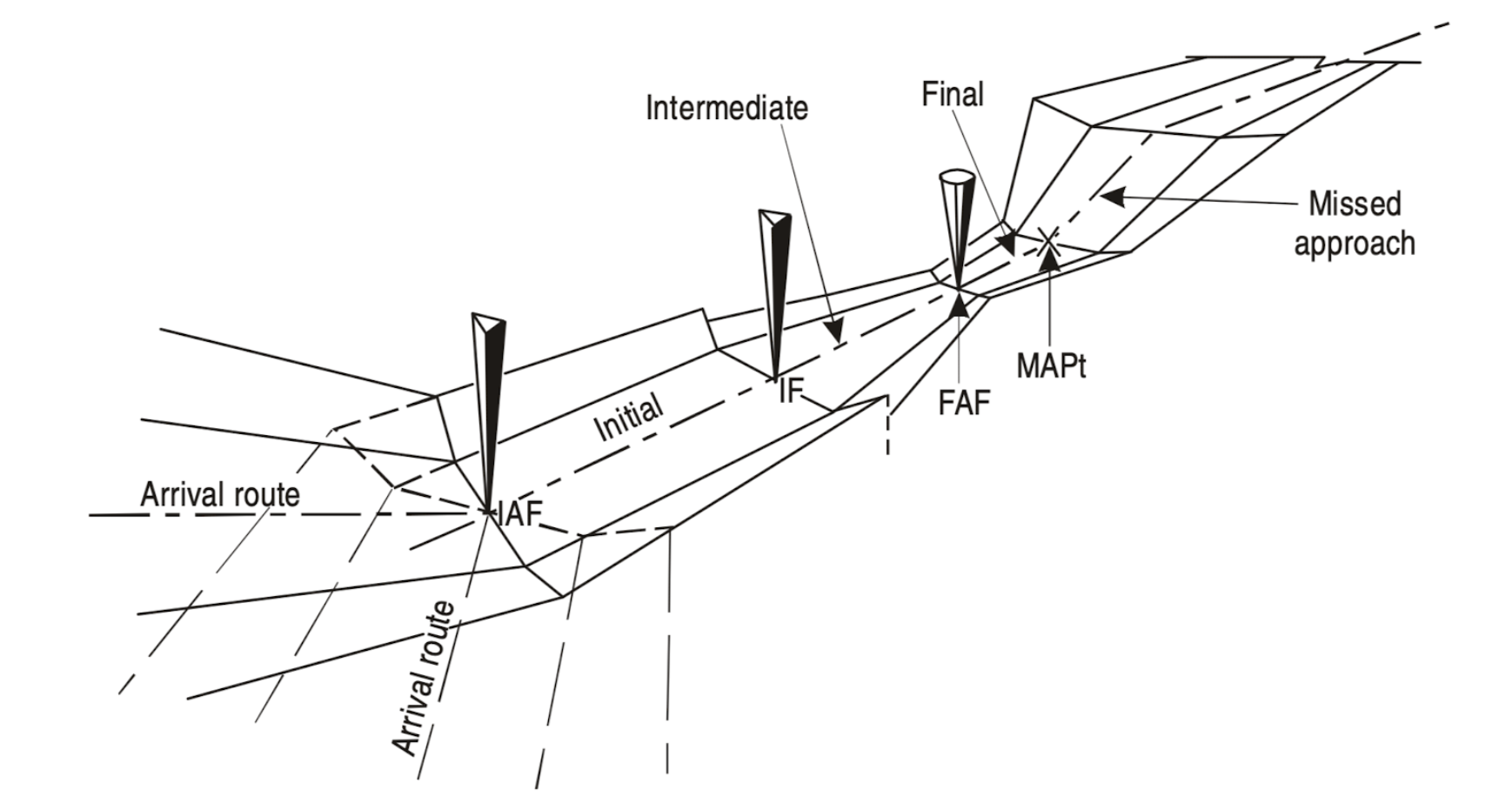
What are the beginning and ending point of a Final approach segment?
The FAS begins at the FAF (NPA) or FAP (PA) and ends at the MAPt (or with a straight-in landing or a circling)
Which types of Final Approach are considered in the Doc 8168?
NPA with FAF
NPA with no FAF
APV
PA
Consider a NPA with a FAF: what are the minimum/optimal/maximum distances of the FAF from the RWY THR?
minimum/optimal 5NM
Max 10NM
Consider a NPA with a FAF: what is the optimal descent gradient in the Final approach segment?
As usual, the optimal G% is 3° / 5.2%
Consider a NPA with a FAF: what are stepdown fixes? which are the operational consequences, if they’re established by the procedure?
Stepdown fixes are fixes on the Final Approach Track associated with a Minimum Crossing Altitude (usually, only one fix is published)
They’re put at maximum 6NM from the facility serving the procedure
Operational consequence: pilots have 2 OCA/H values: the higher for the normal procedure, and a lower one to use if the stepdown fix is positively identified. This allows pilots to descend further to search the RWY environment
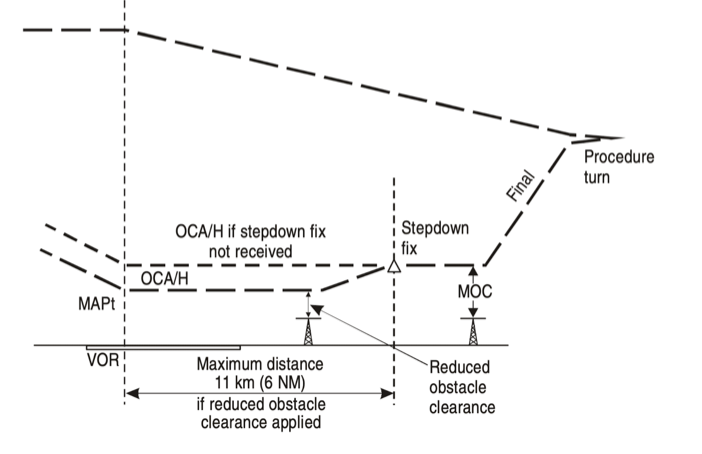
Consider a Precision Approach: where does the Final Approach Segment begin and end?
The FAS begins at the FAP (point in space where G/P intercepts the intermediate approach ALT/Height) and ends at MAPt or landing or start of the Circling Manoeuvre
Consider a Precision Approach: what’s the typical length of the final approach segment?
Interception of the G/P usually occurs 1000’ to 3000’ above threshold. At an angle of 3° it corresponds to a range of 3NM to 10NM
(1:60 rule: short segment = long segment * angle / 60.
short segment = altitude, let’s pick 1000’
angle = 3°
long segment = x =60×1000/3 = 20000’ = 3NM roughly)
With altitude 3000’, x = 60000’ = roughly 10NM
Which factors mainly affect the determination of DA/H in a precision approach, and why?
Aircraft category
The type of altimeters used (radioaltimeter or pressure altimeter)
Wingspan
Vertical distance from GP antenna to wheels flight path
The main issue is that aircrafts and their engines have inertia, hence continue to descend for some seconds even after having selected TO/GA thrust
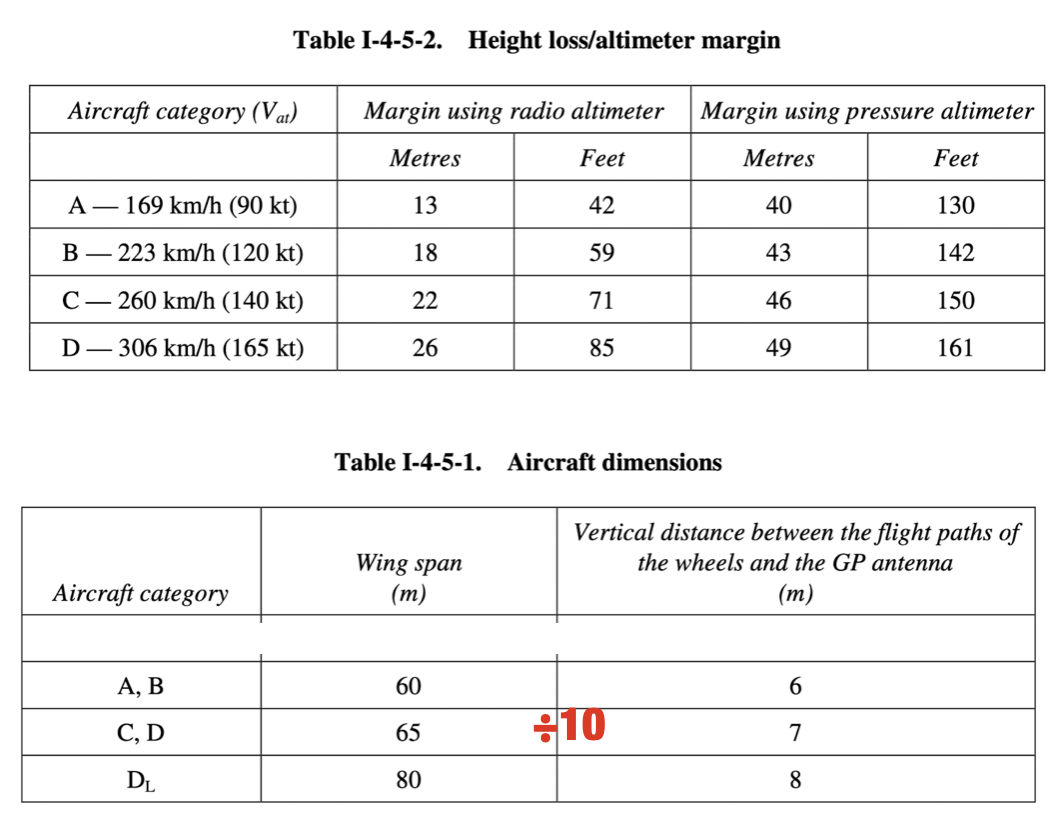
Talking about aircraft approach categories, what’s the difference between class D and class DL?
(note: very tricky question, but if you learn it, you have covered ALL the possible aircraft approach categories)
Cat. D and DL have the exact same Vat interval (141-165 kt)
However, cat DL is for aircraft with a wingspan ≥ 80m and a vertical distance between wheels flight path and GP antenna of ≥8m.
For cat D, wingspan was 65m and vertical distance 7m
The values are took from this table, used to determine DA/H for PA
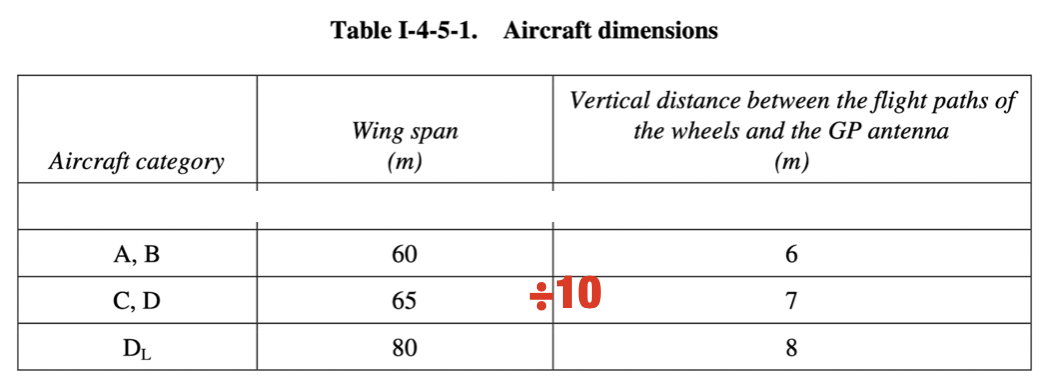
Speaking about the Final Approach Segment of a PA, how is a Non-Standard Procedure defined?
A procedure involving a Glide Path > 3.5° or a ROD of more than 1000ft/min.
It requires specific approvals for operators, aircrafts and crews and attentions to other aircraft systems and conditions (speed control, wind limits, GPWS, windshear, …)
What is the maximum deviation for LOC and GS in a PA final segment?
Half scale deviation for LOC
Half scale deviation for GS
Which are the 3 phases of a Missed Approach Procedure?
Initial, Intermediate, Final
What is the purpose of the Missed Approach Segment?
Provide safe obstacle clearance during a missed approach procedure
What’s the definition for MAPt, Missed Approach Point?
PA / APV: intersection of electronic G/P with DA/H
NPA: a specified distance from the FAF (or a fix / timed)
Say what you know about climb gradients during a missed approach procedure
nominal / optimal: 2.5%
may be lowered to 2% by surveying the area
Not everyone can attain 2.5% in OEI conditions, so special procedures with higher DA/MDA may be issued
Under specific approval, gradients of 3%, 4%, 5% may be used when aircraft performance allow and this result in operational advantages
(Whole content about the topic from the DOC 8168: there’s nothing more to know)
List all the starting and ending points of the 3 phases of a Missed Approach Procedure
Initial: MAPt to Start of Climb (SOC)
Intermediate: SOC to point where 50’ OBS CLR is achieved
Final: where 50’ CLR is achieved to a fix (where a new approach can be started, or a holding, or return to ENR, …)
Talk about turns in the 3 segments of a Missed Approach Procedure
First, let’s point out that turns in the initial stages go a MAP are specified only if strictly necessary (terrain, obstacles ahead, …)
Initial: no turns allowed, pilots just have to change the config and climb
Intermediate: minor TRK corrections are assumed. Turns of MAX 15° change in TRK are allowed
Final: turns are allowed
Which speeds are assumed to be used to define maneuvers (such as MAP turns, Circling, Initial Approach, …), according to Section 4, Icao Doc 8168? (just name them)
ICAO defined a range of assumed speeds for a few maneuvers and for each aircraft category.
They’re the “Speeds for procedure calculations”
note: this question has been created just to let you know. I am not aware of any advantage in learning them, but they are referred to in some sections (MAP turns for example)
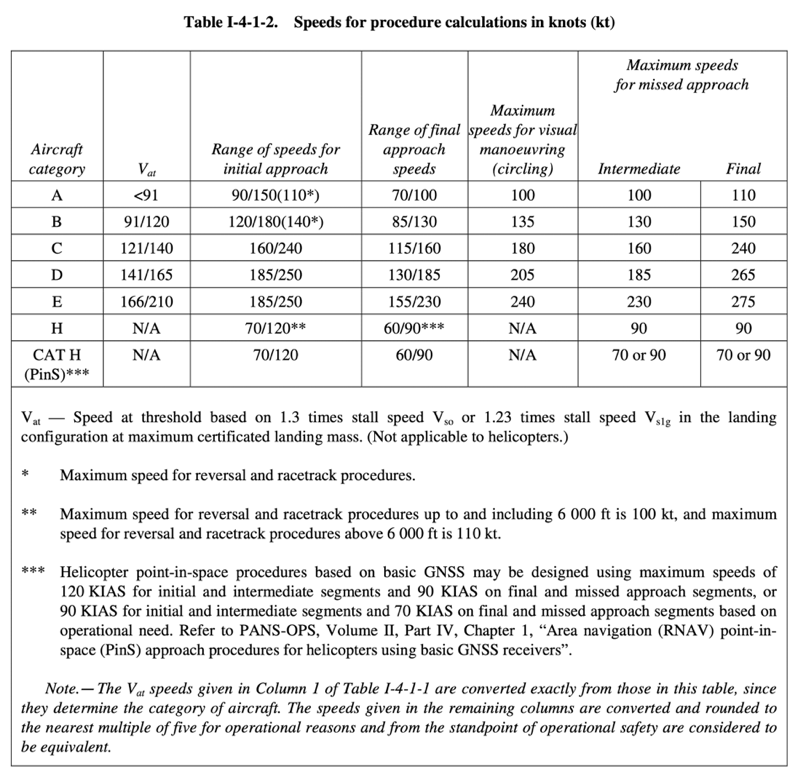
Define Circling
The visual flight phase after an IAP to reposition the aircraft to land on a RWY not suitable for a straight-in approach
Why a well-defined "Circling procedure” cannot exist?
Because each circling situation depends on runway layout, terrain surrounding the airport, wind, weather, … It is not practical to attempt to define a unique circling procedure
What must you constantly have in sight during a circling?
The runway environment: elements such as the landing threshold, the markings, the ALS, …
How is the circling area constructed?
Arcs of variable radius centered in each runway threshold, joined by tangent lines.
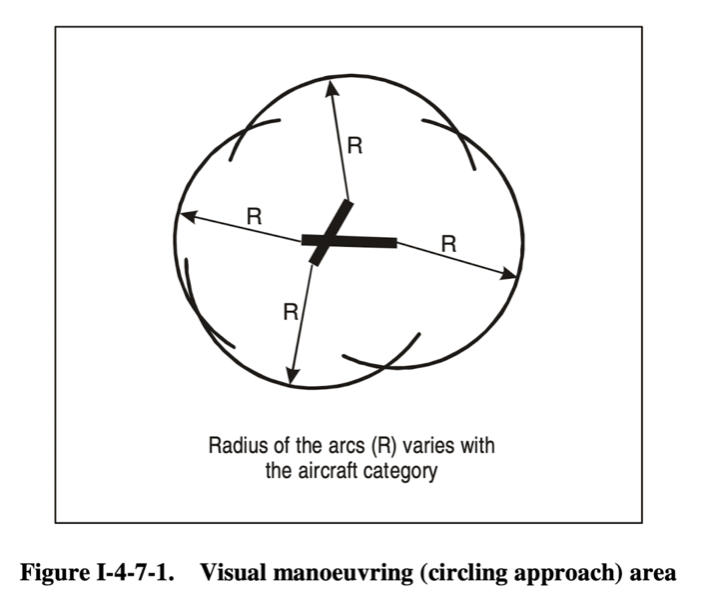
What does the radius of the circling area depends on?
Aircraft category, wind speed and bank angle
What is the minimum obstacle clearance that has to be provided during Circling? What is the minimum visibility to achieve? remember: it depends on aircraft category
Circling MOC
A, B: 300’
C, D: 400’
E: 500’
Circling Minimum Visibility [NM]
A 1
B 1.5
C 2
D 2.5
E 3.5
What is the procedure to follow in case you need to start a missed approach during Circling?
Climbing turn towards the landing runway
Overhead the aerodrome > Follow the MAP TRK for that procedure
Talk about Visual Maneuvering (Circling) using prescribed TRKs
Prescribed TRKs are defined by the State
Pilots must be familiar with surrounding terrain and visual cues
It is a completely VISUAL manoeuvre
Each segment is defined by direction, length and eventually a speed restriction
It has a protection area of constant width about the C/L, whose semi-width depends on cat. (A 1400m, B 1500m, C 1800m, D 2100m, E 2600m)
Same MOC values for normal Circling
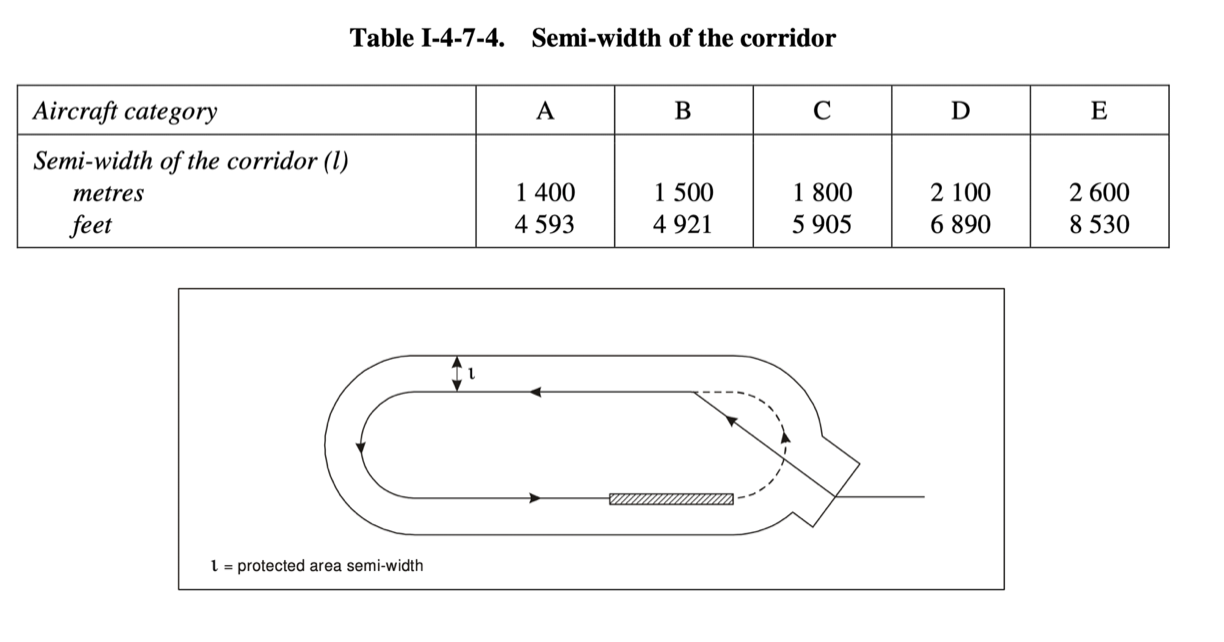
What is the semi-width of the corridor of the protection area, in a circling using prescribed TRKs?
cat. A 1400m
cat. B 1500m
cat. C 1800m
cat. D 2100m
cat. E 2600m
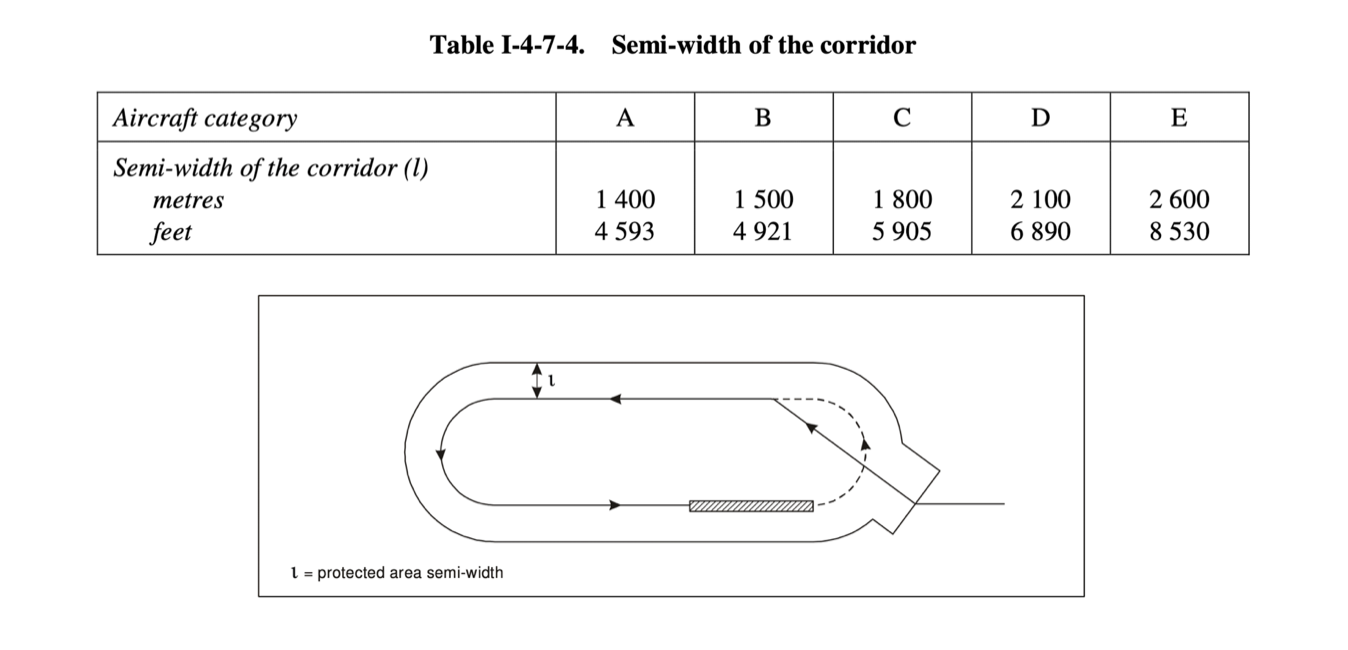
Regarding procedure naming conventions, what does the letter Y mean, in the procedure title “ILS Y RWY 35”
The single-letter suffix is used whenever two or more procedures cannot be distinguished by type of radio-aid serving the aerodrome.
In this case, the procedure is the 2nd ILS procedure for RWY 35, the first being called “ILS Z 35”. The two procedures probably differ for something like MAP, final segments, arrival routes, …
Regarding procedure naming conventions, what does the “or” mean, in the procedure title “NDB or ILS RWY 26”
The “or” means that the plate contains multiple procedures sharing the exact same intermediate, final and MAP segments. Pilots can use the plate to conduct either an NDB or an ILS for RWY 26
What is the maximum number of MAP that can be established for a single IAP?
Only 1
What is the accuracy of descent gradients and angles listed in procedure charts?
1/10th of a % or a ° (0.1% or 0.1°)
What is the accuracy of descent gradients and angles encoded in navigational databases?
1/100th of a % or a ° (0.01% or 0.01°)
Where do descend paths originate from?
50’ above landing threshold, but origin may change for precision approaches.
How many ft below descent path is the FAF altitude published?
Published FAF altitude is 50’ below the descent path at the FAF (to prevent overshooting of descent path)